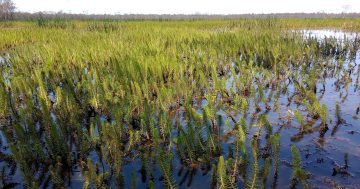
The epicentre of trout fishing in Australia – the Monaro region – has been dealt a blow by a decision by the NSW Department of Primary Industries. Photo: Alistair McBurnie.
A decision by the NSW Department of Primary Industries (NSW DPI) to disallow the restocking of trout in some major Snowy Mountains streams and rivers, claimed to have the species’ best fishing on the Australian mainland, is set to pulverise the Monaro region’s economy.
Department concerns around threatened native fish species mean communities reliant on the thousands of anglers who visit the alpine region off-season now face an uncertain future, says Kerry Pfeiffer, the new president of the Monaro Acclimatisation Society (MAS).
But it’s not just the implications of this determination in communities downstream of the DPI’s NSW Fisheries Threatened Species Unit Mr Pfeiffer is concerned about, but what he sees as a lack of regard shown to a historic affiliation long credited with the success of inland recreational fishing.
Recreational fishing generates about $3.4 billion of economic activity in NSW each year, contributing around $250 million annually to inland NSW, reaching around 900,000 anglers annually in NSW and the ACT alone.
The DPI says the recreational trout fishery in NSW has largely been built on the success of stocking pioneers and the efforts of voluntary groups such as the MAS, established around 47 years after trout were first unofficially released in the Monaro in 1888.
Now in its 160th year, with 19 branches stretching across the Snowy Mountains, South Coast, ACT and Southern Tablelands, MAS works with NSW Fisheries collecting and distributing about 300,000 trout bred and grown at the Gaden hatchery near Jindabyne biannually and in accordance with environmental impact guidelines.
MAS members see themselves as local managers of the trout, working doggedly under a charter that ensures quality recreational fishing is maintained through conservation of the natural environment, appropriate management of fishing and adequate populations of trout.
This highly collaborative established relationship cemented MAS a place at the table as a primary stakeholder with DPI (Fisheries), recognised under the Fisheries Act 1935 (NSW).
Beyond the rivers, streams and lakes, the group’s contribution to policy and legislation affecting freshwater fish in NSW is recognised by the Recreational Fishing NSW (RFNSW) Ministerial Advisory Council and is a key plank of the NSW Government’s plan to enhance recreational fishing opportunities across the state.
But just weeks ago, ahead of the 5 February AGM, an incensed and disappointed Steve Samuels suddenly and publicly stepped down from his 29-year tenure as MAS president, taking the unusual step of publishing his 2024 president’s report via social media.
Mr Samuels said he was shocked to receive advice from NSW Fisheries, in August 2023, that several MAS traditional trout-stocking sites would no longer be allowed to be stocked due to a decision by the NSW Fisheries Threatened Species Unit to protect the endangered native Galaxias terenasus and Macquarie perch species of fish.
This impacted a significant section of the middle Maclaughlin River, about half of the Cambalong Creek, a significant section of the Snowy River, including the reach that runs through Dalgety township, and most of the Delegate River, which includes the reach that runs through the Delegate township.
Mr Samuels said MAS was also informed it would no longer be able to stock rainbow trout in the whole of Adjungbilly Creek near Tumut and the whole of the Murrumbidgee River upstream from the Numeralla River confluence to Tantangara Dam and beyond.
“The MAS stopped stocking brown trout in these sections in 2004 in line with the regulations to protect, but the extension to now prohibit rainbows was again a complete surprise,” he said.
“We have tried to elicit from NSW Fisheries what has changed to bring about this decision, but all we have been told is that it is to do with Macquarie perch.”

The first trout were introduced unofficially to the Monaro in 1888. Photo: NSW DPI Fisheries Facebook.
Mr Samuels said more disappointing was the clandestine way the process had unfolded, especially involving consultation around the Commonwealth threatened species listing of Galaxias terenasus.
“The MAS was unaware that it was occurring, and as it turns out neither [sic] was the Recreational Fishing Unit of NSW Fisheries,” he said.
“This new species [Galaxias terenasus] has been co-existing with trout since stocking began and despite the research indicating that the species is increasing on the Monaro, the limited research to establish a limited population was enough for the little fish to be declared endangered.”
Mr Samuels is also dubious about a lack of disclosure from DPI around the restocking of endangered native trout cod in the Goodradigbee River, west of Canberra.
“The MAS only found out when a trout cod was discovered by one of our members,” he said.
”If this had not happened, the clandestine stocking could have continued for years and anglers jeopardised if they kept one for the table thinking it was a Murray cod.”
Penalties for capturing trout cod can include fines of up to $220,000 and/or two years in prison for harming, possessing, buying or selling them, or harming their habitat.
Kerry Pfieffer says decisions being taken on environmental grounds need to give appropriate consideration to other important factors.
“Trout angling is deeply embedded in the historical, cultural, social and economic fabrics of the Monaro region,” he said.
“DPI [Fisheries]-commissioned research has shown the significant economic contribution that trout fishing makes to the region, mainly in the warmer months of the year, supporting tourism in the region beyond the peak snow season.”
He has appealed to NSW Agriculture Minister Tara Moriarty and DPI Acting Director-General Sean Sloan to reconsider the restocking bans.
NSW DPI said it was committed to conserving threatened species populations and ecological communities while promoting recreational fishing opportunities, including the maintenance of production and stocking capacity to continue to provide quality trout-fishing opportunities.
A department spokesperson said more than 2.46 million salmonids, including rainbow trout, brown trout, brook trout, Atlantic salmon and tiger trout had been introduced into NSW waters in 2022-23.
“NSW DPI’s stocking locations are reviewed annually to ensure fish produced out of our hatcheries are stocked into the most suitable locations for recreational anglers, and important threatened species are protected [including newly listed species],” they said.
“The assessment process for stocking fish in NSW waters complies with protections for all listed threatened species under both state and federal legislation and the nomination and listing of any new threatened species or populations is a public process open for comment.
“As a result, some trout-stocking sites for the 2024-25 season have been moved to alternative sites within the same waterways and there was no change to the number of trout stocked.”
Original Article published by Edwina Mason on About Regional.








